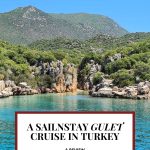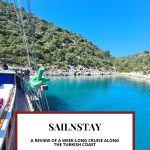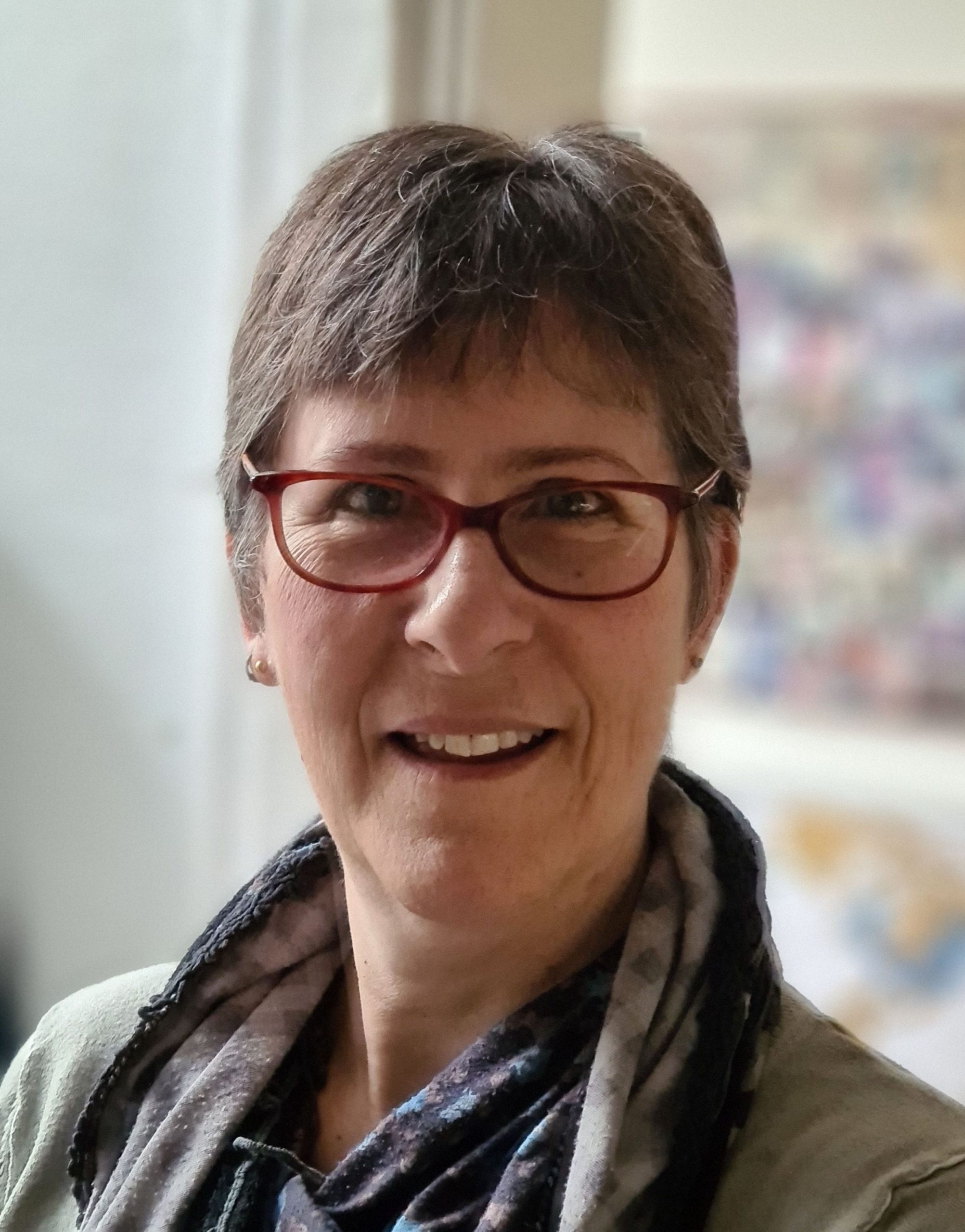Cruising the Turkish coast with Sailnstay: A review
The ship glides smoothly on impossibly clear, deep-blue water. Reclining on a padded seat in the shade, I’m conscious of the tickle of the breeze and the salty smell of the sea air. I watch idly as the craggy, unihabited islands slide by.
Does this image appeal to you? It describes how my daughter and I spent much of our time on a week-long Sailnstay gulet cruise along the south coast of Türkiye (formerly known as Turkey).
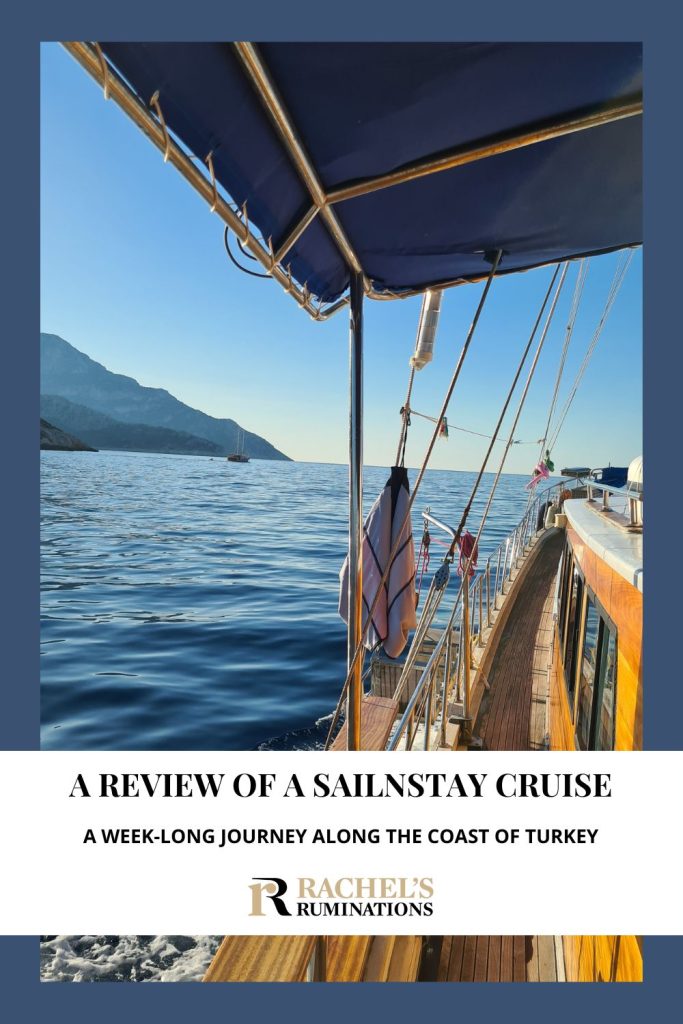
Disclosure: Our cruise with Sailnstay was sponsored. However, Sailnstay has no influence over what I choose to write about our experience. I have tried to be as unbiased in my evaluation as possible.
And another disclosure: This article contains affiliate links. Making a purchase through an affiliate link will mean a small commission for this website. This will not affect your price.
First of all, what is a gulet?
A gulet is a type of wooden boat built in Turkey. Originally the locals used them as sailboats for fishing and cargo, but nowadays they are pleasure boats for tourists. And while they still look like sailboats, with two or three masts, they’re rarely used that way. They run on diesel fuel.
Despite their traditional look, most gulets you see these days are not particularly old, and the original design has been modified to accommodate things like private cabins, bathrooms, large deck areas and, of course, an engine room.
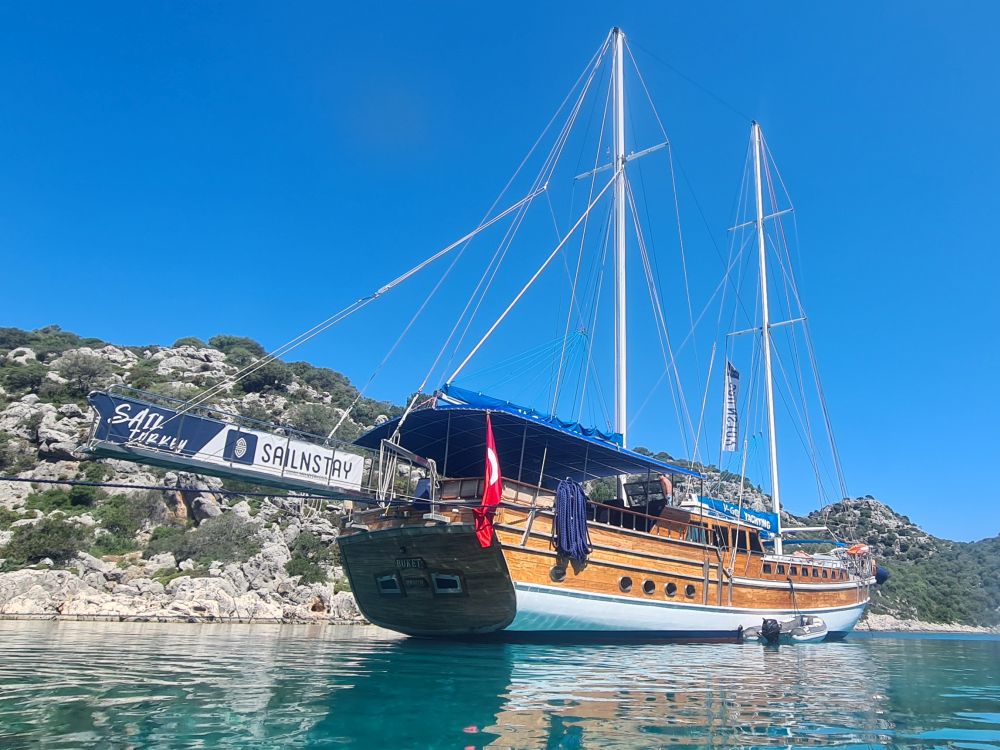
What is the ship like?
Outside, on the deck, our Sailnstay ship, the Buket, has two areas for passengers. The stern has a roof over it, open on all sides. A long, heavy table stands across the middle of the space, with a wide, padded bench along the back of the boat on one side and chairs on the other. The captain’s helm is also here in the shade, and the counter around his workspace doubles as the ship’s bar.
The rest of the ship, forward of this shaded area, is in the sun. Much of it is covered in single-mattress-sized cushions, perfect for sunbathing during the day or sleeping under the stars at night. There’s also, at the front of the sundeck, another, smaller, padded bench with a shade over it. The anchor mechanism is at the very front, and a metal barbeque extends off the side of the railing.
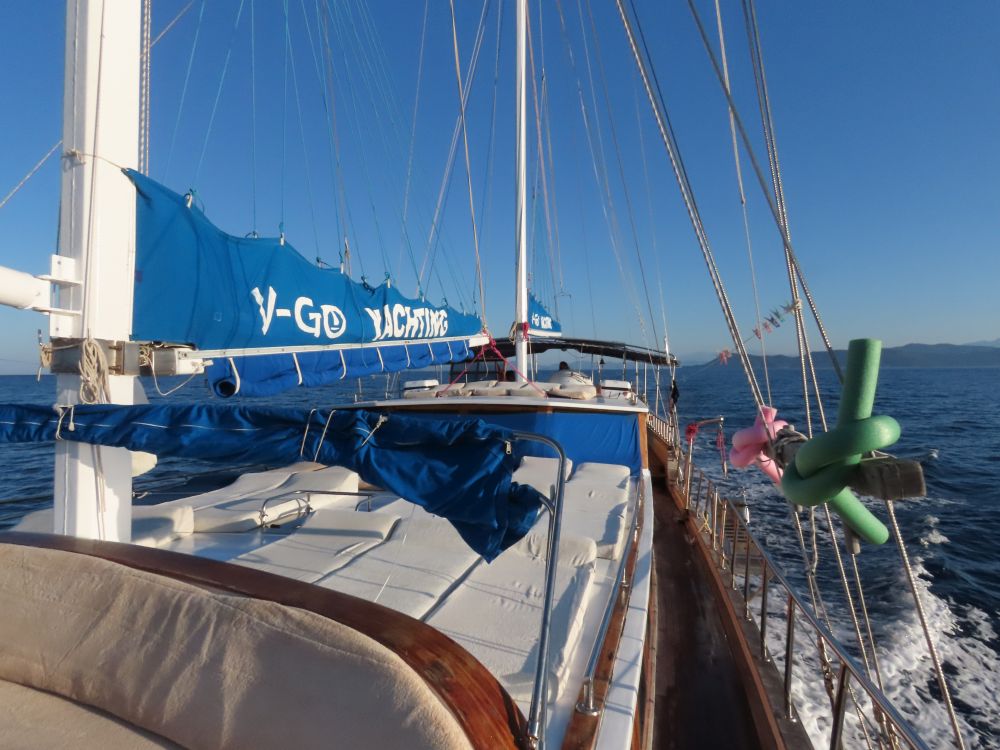
On one side of the ship, about halfway along its length, a steep metal ladder leads down to the water. We used this ladder to get in and out of the water – some passengers just jumped from the deck – and to get in the small rubber motorboat to get to shore at some of our stops.
Inside the ship, down a few steep steps, is an area mostly used by the crew. One side serves as the galley – the kitchen – with a counter dividing it from the rest of the space. The chef puts the prepared food there for the crew to deliver to the big table outside. There’s a sitting area here inside too, but I never saw any passengers spend time here. It was too pleasant to be out in the open air.
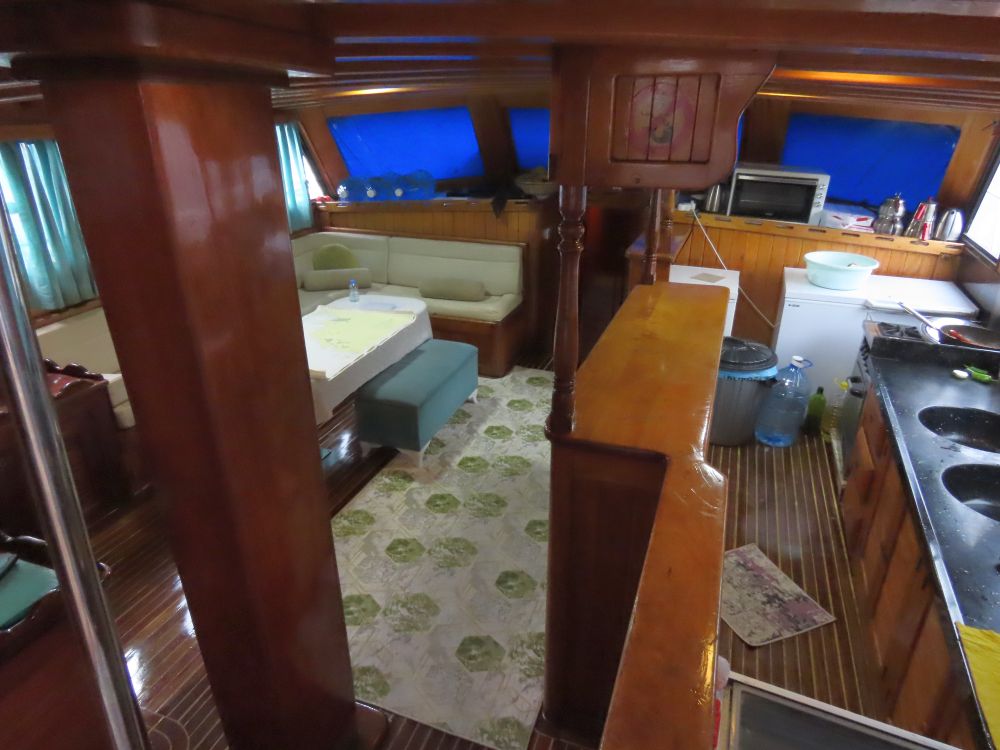
The cabins are a few more steps down another steep stairway and along a short hallway under the sundeck. A few more cabins are tucked away on a short hallway under the stern. Of course, other gulets may be larger or smaller, but the ones we saw during our week-long sail all looked pretty similar.
What are the cabins like on a Sailnstay ship?
The cabin
My cabin was clean, but very small. It held a double bed with a single bed above it. A cupboard was partly filled with an extra blanket and several life vests, so I ended up just leaving my luggage open on the floor. That pretty much filled up the floor space, except where the door to the cabin opened.
Since I had the cabin to myself, I was able to put my extra things – the suitcase of clothing I would use on other parts of the trip, my handbag, my computer bag – on the upper bunk. If you shared the cabin with one or two other people, I think it would be quite crowded. The upper bunk is accessed by a good, solid ladder, and there are two small windows on the wall next to it that can be opened.
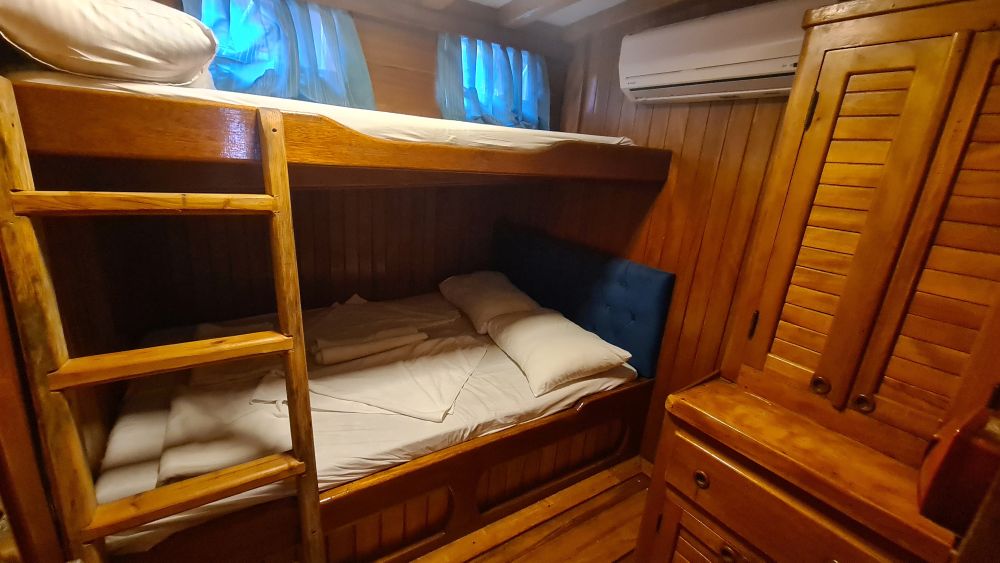
The mattress was very comfortable: not too hard and not too soft. Even though it was early May, the thin cotton blanket was more than enough.
The cabin also includes a large air-conditioning unit, which I never needed to use. In the summer, you would surely need it, yet it isn’t always available. To save fuel and to provide some peace and quiet, the electricity gets turned off sometimes.
According to comments I’ve read online, many guests sleep outside at night. They take the cotton blankets off their beds, spread them on the mattresses that cover the upper deck, and sleep in the open. Guests use those mattresses during the day as well, and I can attest to them being very comfortable.
My daughter’s cabin – the ship wasn’t full and since we’d asked for twin beds, the crew offered us separate rooms – had only the double bed, not the bunk above. It had a bit less floor space, and the same cupboard that was mostly already full.
The bathroom
Each cabin has its own bathroom, which isn’t as small as I expected. It surprised me – and the other passengers – to see that the bathrooms have no shower. The closest example I could compare this bathroom to is the one I had on the De Nassau on my first Boat Bike Tour. There, the bathroom was smaller, yet it had a shower, a toilet and a small sink. This bathroom is bigger in square footage, with a big sink and a toilet. Instead of a shower, though, it has a pull-out shower hose that doubles as the tap on the sink. That means that to take a shower, you have to hold it over your head. It also means that the whole bathroom will end up wet.
When I first arrived on board and saw that there was no shower – and no bracket to hang the hand shower on – I worried that it would be a long and, eventually, smelly week. But it didn’t turn out that way.
One of the joys of a cruise like this is the many opportunities to swim in the clearest water I’ve ever seen. After I took the plunge, I’d climb back up the metal stairway and rinse off using the shower hose provided at the top. It’s outside, in your bathing suit, but you can manage a pretty good rinse that way. And you rinse off your swimsuit at the same time.
After rinsing, I’d dry off and warm up in the sun – the water in early May is very cold! Then, back in my cabin, I’d do a bit of spot-cleaning using soap and shampoo and that pull-out shower hose. That worked fine.
How are the food and drinks on a Sailnstay cruise?
Given that Sailnstay is an agent and books guests to a number of different boats run by a number of different companies, I can’t generalize about food and drink. What I can say is that the chef on our ship put together three very tasty and hearty meals for us every day – an achievement, coming out of such a small space. The food was mostly standard Turkish fare, with a range of meat and vegetarian dishes and side dishes. It wasn’t fancy, but it was fresh, tasty and filling. There was plenty of choice at every meal as well.
The food was served family-style. We all sat around the big table and the crew set platters out down the middle. Especially at first, that served to foster connections between the guests as we passed platters around and commented on the food. Since we spent every meal together for the rest of the week, we all got to know each other pretty well.
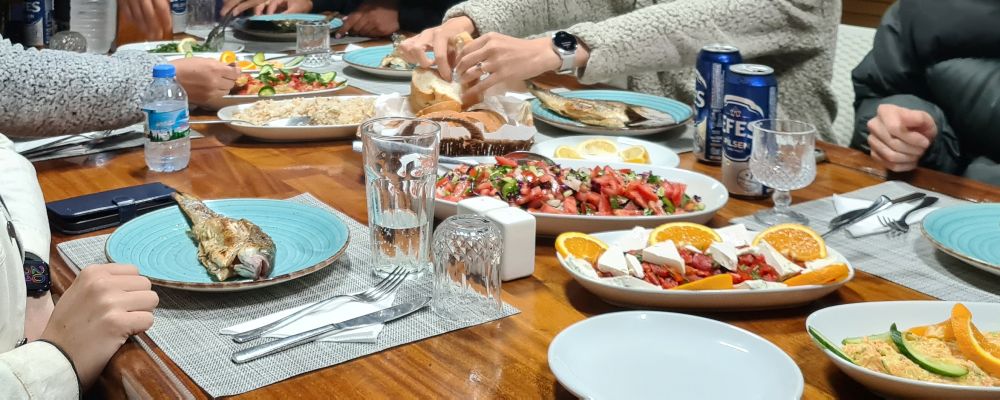
Besides the three complete meals, there was also afternoon tea every day. That was just tea or coffee and small cookies or cakes.
The cost of the tour does not include drinks except for water and, twice a day, tea and coffee. We could order soft drinks, beer, wine or mixed drinks. The prices aren’t cheap, with soft drinks at €3 a can and mixed drinks at €10-€12 each. While the prices are in euros, you can pay in either euros or Turkish lira. In either case, it has to be cash. That’s not a problem, though: you can pick up cash from an ATM in Fethiye easily enough either at the start or the end of the week.
And speaking of drinks, this is an example of where the situation might differ significantly from ship to ship: the mixed drinks on our ship were either not available or not done correctly. The margarita listed on the drinks menu, for example, bore no resemblance to any margarita I’d ever seen or tasted. Since the crew member serving as bartender didn’t speak much English, we couldn’t explain how to make any drinks. It ended up safer just to order beer, wine or a very simple drink like a gin and tonic or a rum and coke. On another ship you might have better results, of course.
How were the other guests?
Sailnstay advertises a range of different styles of cruise, mostly based on age range. The youngest group is 18-39, which they call “young adults.” Then there are cruises for 20-49-year-old “young professionals” and so-called “relaxation cruises” for 30-75-year-olds. They also offer child-friendly family cruises.
We signed up for a “relaxation cruise.” Because our trip was so early in the season, however, they didn’t have enough bookings to fill either our cruise or a younger cruise. Instead, they combined the two tours on one boat.
It didn’t make a difference, fortunately. While the younger set – four New Zealanders and a couple of Australians, all in their mid-to-late 20’s, I’d guess – were certainly more up for a party, they didn’t disturb our peace. They just swam more often and drank more and spent a lot of time lying in the sun. They were also just pleasant people to be around. We had some really fun conversations around the table at mealtimes.
Besides that younger set and my daughter and me, there were a couple of Germans as well as a Russian who lives in Germany. Two very nice older couples from Australia joined the cruise a few days later.
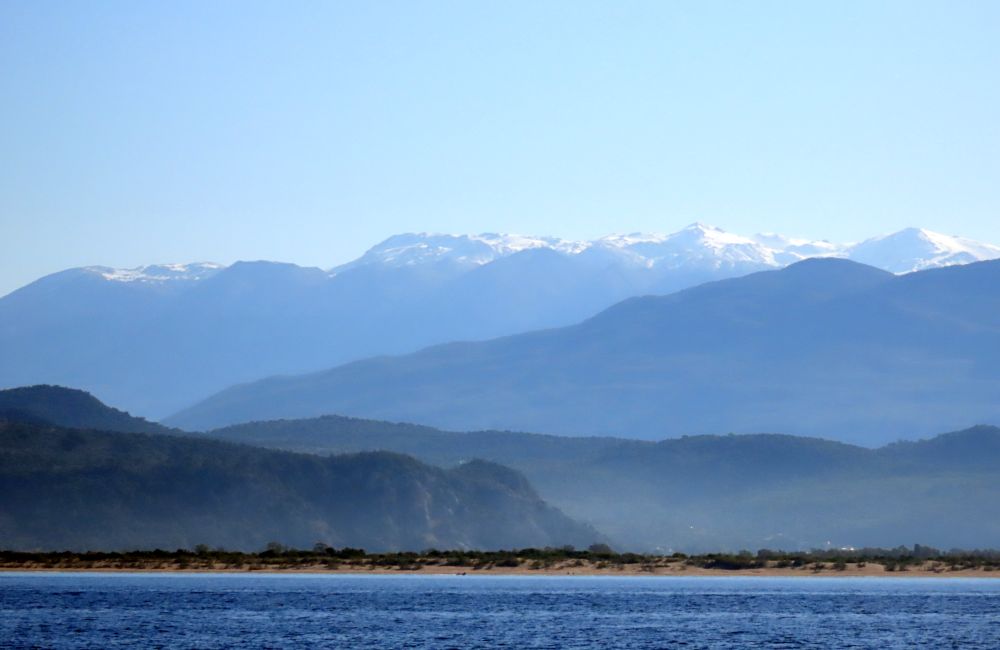
What is there to do on the ship?
It’s a small ship, and there’s not much to do. We mostly spent our time, when we weren’t off the ship sightseeing, lazing around either in the sun on the top deck or in the shade at the back of the boat. Or we went swimming.
Speaking of swimming, the water is very cold in early May! (“Fresh,” as our shipboard friends from Down Under called it!) We all swam, some more than others, because that beautiful, clear-blue water just seemed to beckon.
I’m sure that in the summer, the guests spend less time lazing in the sun and more time in the water. Türkiye gets extremely hot in the summer months. The universal opinion on our tour was that we had chosen the absolute best time of year to take this cruise. It was, to put it succinctly, idyllic.
Our ship carried a single kayak and a paddleboard, as well as snorkel gear. Other than that, we had all brought our own entertainment in the form of books, phones, needlework, and the company of our travel companions.
At some of the stops, other activities were available for an extra charge, but none of the guests did them, so I can’t report whether they were good or not. There was parasailing, jet skiing, wakeboarding and the like. I might have liked to try some kayaking or a jet ski, but once I’d settled into the lazy onboard life, I couldn’t be bothered!
For me, of course, the highlights involved sightseeing, either from the ship – beautiful views and the ruins of the Sunken City of Kekova – or off the ship, such as visiting Simena Castle or St. Nicholas Island.
Book a Sailnstay cruise here. Use coupon code rachelsruminations for a 5% discount!
What was the itinerary for this Sailnstay cruise?
Our cruise started in Fethiye and went as far as Kekova and back to Fethiye, but we didn’t do the cruise in the published order. At the Fethiye end of the cruise the wind was strong and it was a bit chilly, while we could expect better weather closer to Kekova. The crew made the decision that we would go the whole distance in the first two days to get to a place with better conditions, then work our way back slowly.
Here are the places we visited that stood out for me:
St. Nicholas Island
St. Nicholas Island is where the tomb of St. Nicholas – a.k.a. Santa Claus or Sinterklaas – is believed to be located. It’s a tall, craggy island where you can climb to a beautiful lookout point on its top. On the way, you’ll pass ruins of several churches dating to the Byzantine era (4th-7th centuries AD), along with tombs and a graveyard.
There’s also the remains of a long, roofed pathway that connects a rock-hewn church high up on the hill all the way down to the port. That church is purported to be where St. Nicholas was entombed. Given that there are four churches and other religious structures clustered here, the island was probably a religious community.
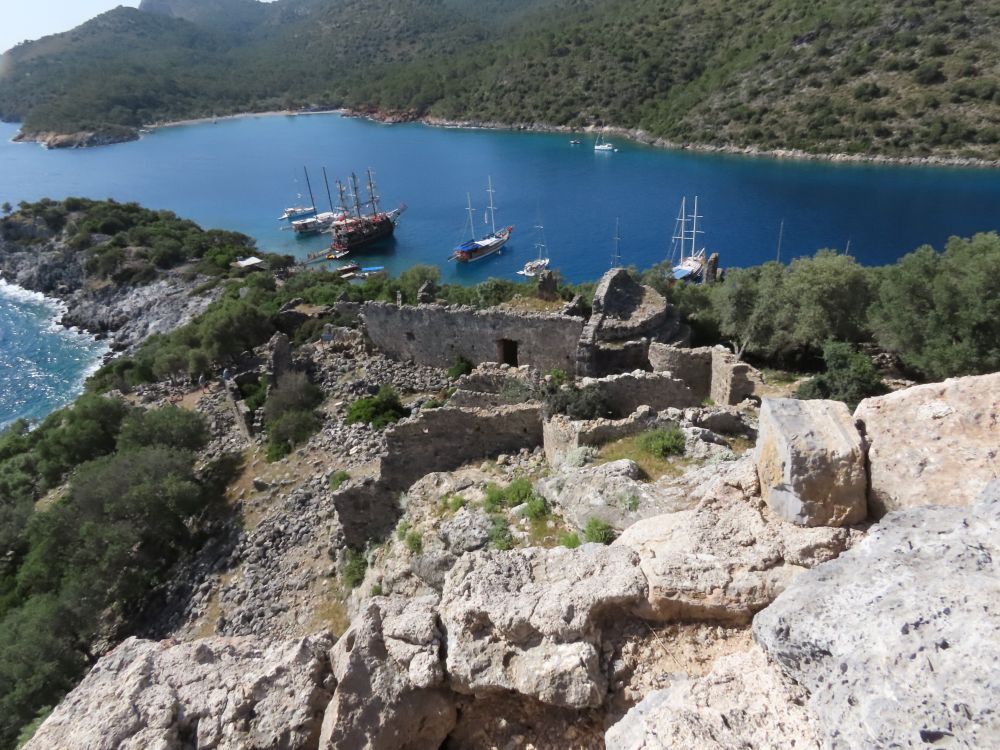
I, however, never reached the top of the hill. The trail is not at all well-marked and I ended up walking to and around many of the ruins. By the time I found my way back to the trail I was too tired to attempt more uphill climbing. Then I lost the trail again when I tried to follow it back down. I kept coming to rockfalls I didn’t dare climb over and having to retrace my steps.
It costs a few euros to enter the island and to go to the lookout. Signs declare that you should stay on the marked trail, but I never saw any markings at all. Nevertheless, the ruins are in a magnificent spot. When I was there, I had the place mostly to myself as I poked around trying to figure out what each structure might have been.
Butterfly Valley
One of the more popular stops on the route is Butterfly Valley. I’m calling it popular because it was the place we saw the most other gulets, all at anchor off the pretty curved beach along with us.
Butterfly Valley is beyond the beach, the beach bar and the campground that backs the beach. It’s a deep cleft in a mountain with a tall, narrow waterfall tumbling down it. Apparently, there are lots of butterflies in the valley during the summer. We did see a few near the beach, but it was early in the season. And we didn’t get to walk into Butterfly Valley at all. The path had been closed because of recent earthquakes that had loosened rocks on either side. Goats climbing those rocks were making them fall, and it was not considered safe to venture into the cleft.
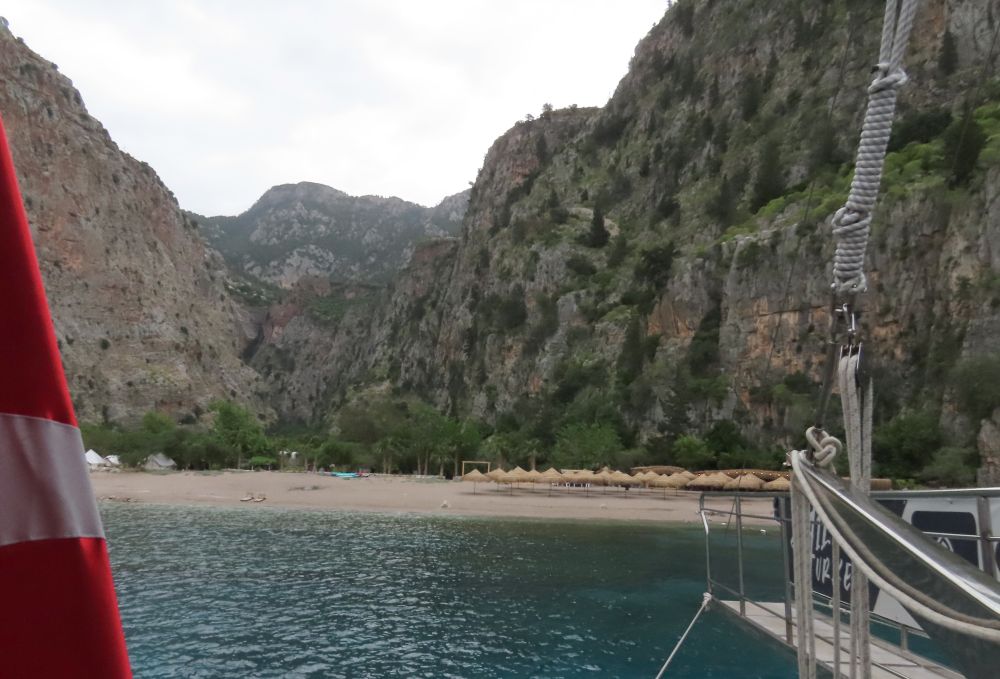
Given the sheer number of tents and small cabins behind the beach, and the five or six gulets off the beach in early May, I’m guessing that this place must get crazy busy in the summer months.
Kekova Island
This uninhabited island once held a Lycian town called Dolchiste, but an earthquake destroyed the town in the 2nd century AD. It was rebuilt in the Byzantine period but later abandoned again with the Ottoman conquest.
Today, the town’s ruins, listed on the UNESCO tentative list, are partly underwater and partly on the shore. No one lives there and no one is allowed to swim among the ruins. We cruised quietly along the shoreline though, close enough to see quite well, including the parts that are underwater, since the water is so clear here. It must have been a big place, at its height, considering how long this stretch of coastline ruins is.
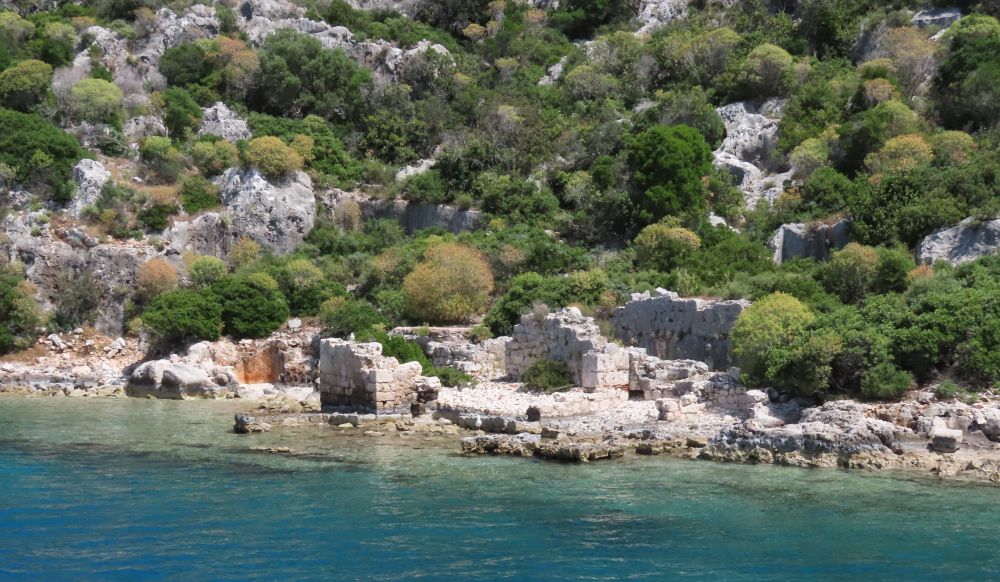
Simena Castle
Simena Castle covers the top of a hill above the small town of Kaleköy. Dating originally to the Lycian period in the 4th century BC, it later became part of the Roman Empire and was also occupied in the Middle Ages.
Today, the castle is a ruin. Its walls are largely intact, seeming to drape around the top of the hill. The remains of several buildings inside the walls are discernible, but in ruins. Just under the castle, but inside the walls, is a small amphitheater carved right into the rock of the mountain. It held 300 people.
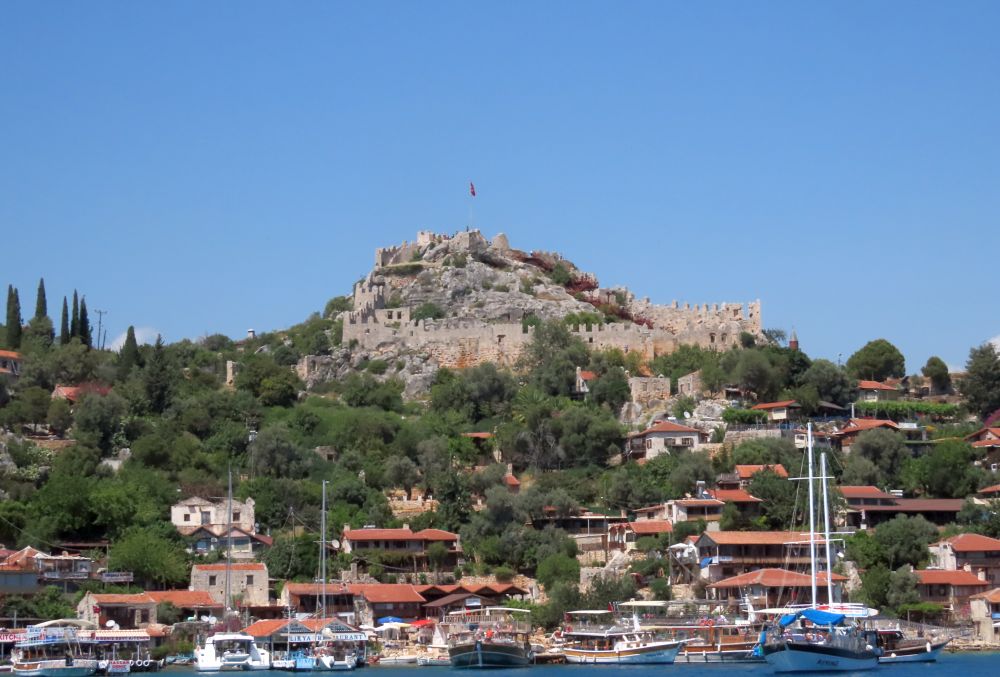
From the castle walls you can see other Lycian remains: an area dotted with rock tombs. Off the shore below are the ruins of a Roman bath and other structures, partly underwater. These were destroyed in the same earthquake as the one that hit Kekova island.
My daughter and I climbed to the top of the castle area along a path that is largely a staircase, paying a small fee to enter the castle. After admiring the view – I never got tired of the sight of that brilliant blue water – we descended again, stopping at one of the many stands hawking locally-made ice cream, then wandering aimlessly through Kaleköy town.
The streets of this car-free little town are narrow – just pathways really – and, despite how tourism-focused the town is these days, it is charming. I suppose that at the height of the summer season it would be crowded and, in the summer heat, much less pleasant. In early May, I would have liked more time to sit, catch my breath and enjoy my ice cream in one of the many cafes.
Kas and Fethiye
We also spent a bit of time in the city of Kas, where my daughter and I went to check out the fully-intact (or rebuilt) Roman amphitheater nearby.
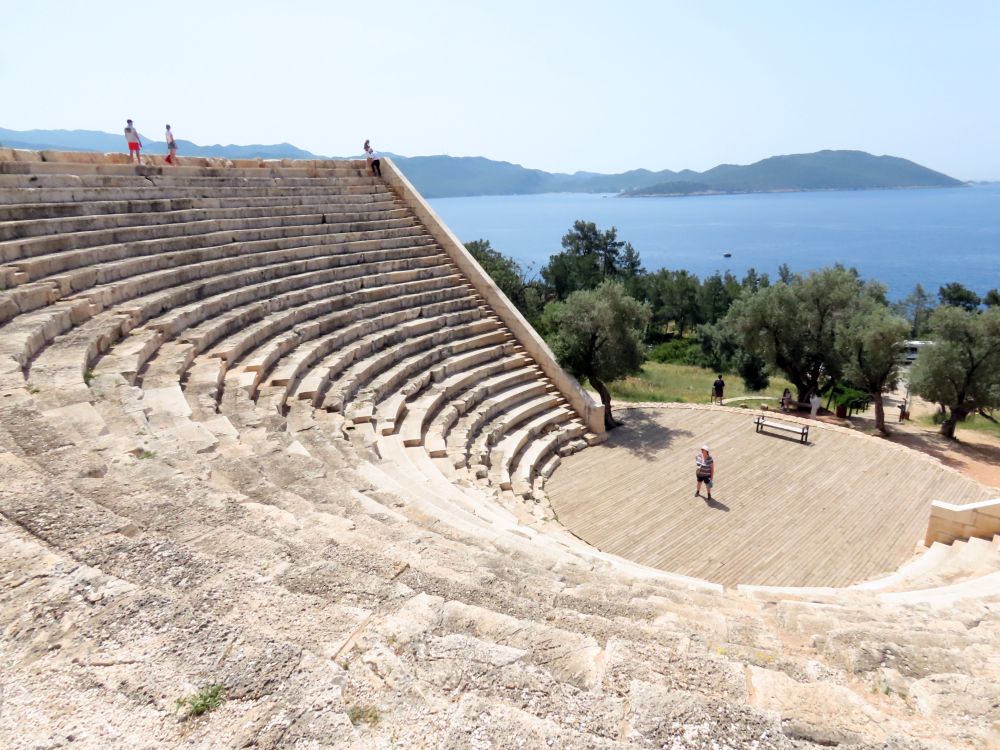
As for Fethiye, our start and end point, it’s a very pleasant resort town with lots of pleasure boats in its harbor. Its market area is, not surprisingly, very tourist-oriented. But it’s cool and shady and we enjoyed eating in an outdoor restaurant there.
How accessible is the ship?
It’s not at all accessible for anyone with mobility issues. Boarding the boat at its starting point involves stepping onto a gangway, then down into the boat. Accessing the cabins involves a short and steep stairway. At the various stops on the route we either could use a gangway or had to go down the steep metal stairway alongside the ship to access a small rubber motorboat, then climb back out of that motorboat when we arrived. And going into or getting out of the water to swim also involves that steep stairway alongside the ship.
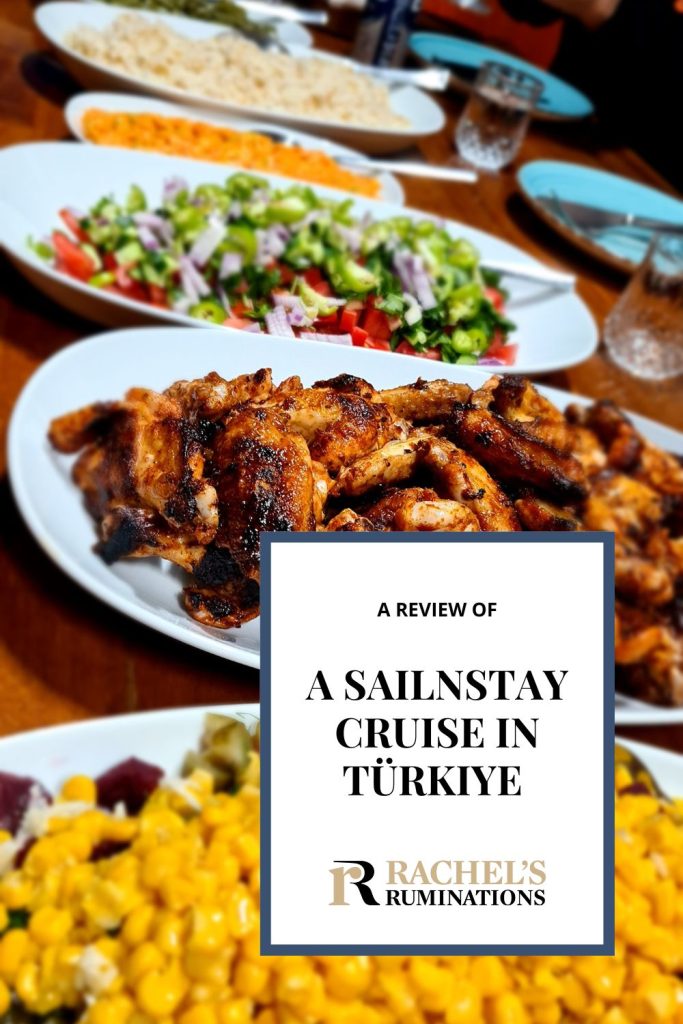
What I liked about the cruise
Once I settled into the rhythm of days on the ship, the enforced idleness of it was a delight. I’m not good at just stopping and doing nothing, but enjoyed it in this absolutely beautiful context. I admit, though, to pulling out my laptop and working sometimes. I felt privileged to have this magnificent scenery as my workplace, even if it was just for a week.
The crew was consistently helpful, attentive and professional.
It was an easy week, with everything taken care of. I didn’t have to pack and unpack, or make decisions about where or what to eat.
The scenery is absolutely gorgeous along this part of the Turkish coast. Most nights we did not dock at a wharf or harbor. Instead, we dropped anchor in a deserted cove where the water was completely calm and there were no signs of civilization. It was so wonderfully quiet at night. And most nights we had the cove to ourselves.
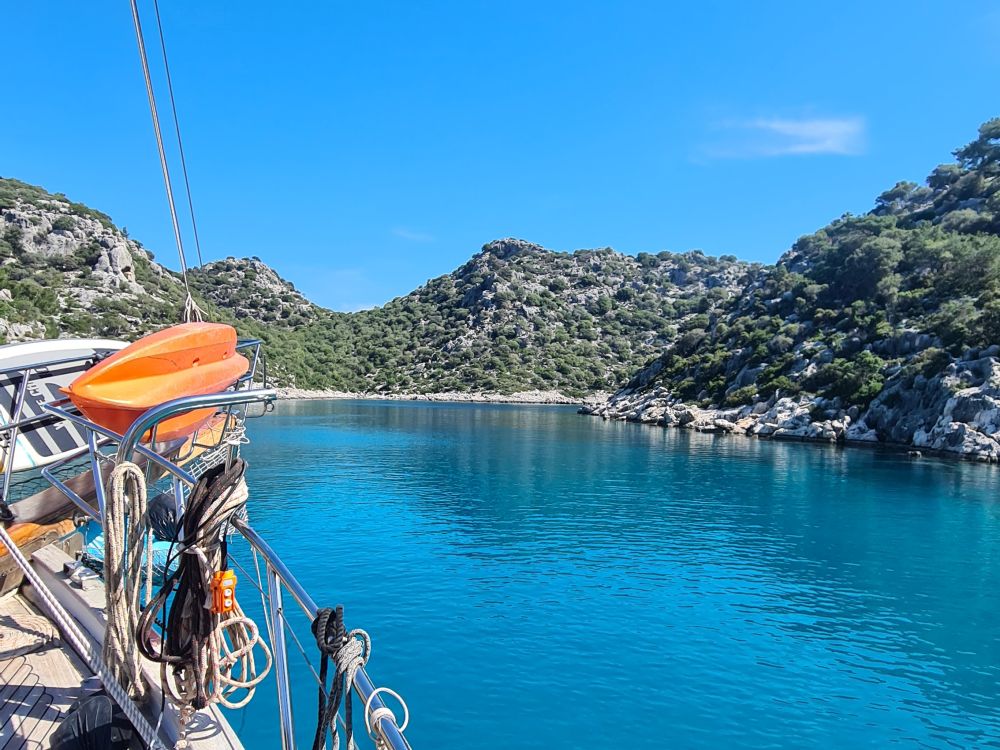
As I mentioned above, the water is a deep blue here and absolutely crystal-clear. It could be over ten meters deep, yet we could still see the bottom. We stopped regularly and could take a dip whenever the motor was turned off.
I enjoyed the historical sights we got to see, particularly Simena Castle and St. Nicholas Island.
What I didn’t like about the cruise
I would have liked a shower stall in my bathroom. If they ever renovate the cabins, they could certainly fit one in, along with a smaller sink.
I’m sure that if I’d taken a summer cruise, I would not have liked that the electricity gets turned off at night. I prefer to sleep in private, not on deck, and without air-conditioning, that would be uncomfortable. On this early-May cruise, it wasn’t a problem at all, and I never needed to use it. We could charge our devices during the day, so we didn’t need electricity at night.
Also I’d be a lot less happy with the cabin if I’d shared it with two other people. It would have been very crowded and hard to stow our things. But as it was, it was fine.
Some advice and tips
Take the cruise in the spring or fall, if you can, rather than the summer. My guess is that fall would be best of all because you’d have cooler temperatures, like we did, but the water would be warmer after the heat of the summer.
We arrived a day early in Fethiye, taking a ferry from Rhodes in Greece. It’s always best for any cruise to plan to arrive at least a day early. Flight or ferry delays can happen, after all. The nearest airport is in Dalaman.
We stayed at Minu Hotel, right in the busy market area in Fethiye and a short walk to the Staynstay office and the marina for the start of the cruise. It was clean and comfortable and surprisingly quiet. To look at other hotels in Fethiye, use the map below:
Bring plenty of sun lotion for the daytime and bug repellent for the evenings for if you might sleep with the windows open or sleep out on deck. Also bring a hat with a brim and sunglasses.
Bring something to do – books to read, for example, or a deck of cards. There’s a lot of downtime on this trip. Don’t expect entertainment; just enjoy chatting with other guests or watching the scenery pass by.
I’ve never tried it, but one of the Australian guests told me about saltwater soap. It’s a special soap that lathers in seawater. What I don’t know is whether it’s environmentally friendly. It might be worth looking into, in any case. You could wash in the sea and just rinse when you come out.
Pack as light as you can. Nobody minds if you wear things more than once, and, especially if you take a summer cruise, you’ll probably be in your bathing suit most of the time anyway. Bring a beach towel or buy one in Fethiye before you leave; you won’t be provided with one. Also pack pajamas you don’t mind people seeing you in if you think you might sleep on deck.
Book a Sailnstay cruise here. Use coupon code rachelsruminations for a 5% discount!
The onboard wifi only sometimes works. The modem needs electricity, so when the power is off, so is the wifi. It also gets very weak or disappears entirely when the boat anchors in these tiny coves, surrounded by rocky hills.
Ideally, you should just enjoy disconnecting from the rest of the world and relaxing for a time. But if it’s important to you to have wifi at all times, you’ll need to either make sure you have an e-sim that covers Türkiye, or do as I did and use a portable modem. We got it (sponsored) from WiFicandy. Since it’s portable, you can charge it when the electricity is on and use it when it’s off. It still lost the connection in the more isolated coves, but it did better than the ship’s wifi, and it was really easy to use. (If you order one, use the code RACHELSRUMINATIONS for 10% off.)
My recommendation about taking a Sailnstay cruise
Would I recommend this cruise? Definitely. It’s not what you usually picture when you hear the word “cruise,” but if your goal is simply relaxation and enjoying beautiful scenery, a Sailnstay gulet cruise will provide it: all day, everyday! It’s not luxurious in the way that a traditional cruise is – see my reviews of the river cruise I took with VIVA, or my review of a Princess cruise – but it still offers a self-indulgent, relaxed week on the water.
Is this Sailnstay cruise something you think you’d enjoy doing? Add a comment below!
My travel recommendations
Planning travel
- Skyscanner is where I always start my flight searches.
- Booking.com is the company I use most for finding accommodations. If you prefer, Expedia offers more or less the same.
- Discover Cars offers an easy way to compare prices from all of the major car-rental companies in one place.
- Use Viator or GetYourGuide to find walking tours, day tours, airport pickups, city cards, tickets and whatever else you need at your destination.
- Bookmundi is great when you’re looking for a longer tour of a few days to a few weeks, private or with a group, pretty much anywhere in the world. Lots of different tour companies list their tours here, so you can comparison shop.
- GetTransfer is the place to book your airport-to-hotel transfers (and vice-versa). It’s so reassuring to have this all set up and paid for ahead of time, rather than having to make decisions after a long, tiring flight!
- Buy a GoCity Pass when you’re planning to do a lot of sightseeing on a city trip. It can save you a lot on admissions to museums and other attractions in big cities like New York and Amsterdam.
Other travel-related items
- It’s really awkward to have to rely on WIFI when you travel overseas. I’ve tried several e-sim cards, and GigSky’s e-sim was the one that was easiest to activate and use. You buy it through their app and activate it when you need it. Use the code RACHEL10 to get a 10% discount!
- Another option I just recently tried for the first time is a portable wifi modem by WifiCandy. It supports up to 8 devices and you just carry it along in your pocket or bag! If you’re traveling with a family or group, it might end up cheaper to use than an e-sim. Use the code RACHELSRUMINATIONS for a 10% discount.
- I’m a fan of SCOTTeVEST’s jackets and vests because when I wear one, I don’t have to carry a handbag. I feel like all my stuff is safer when I travel because it’s in inside pockets close to my body.
- I use ExpressVPN on my phone and laptop when I travel. It keeps me safe from hackers when I use public or hotel wifi.


